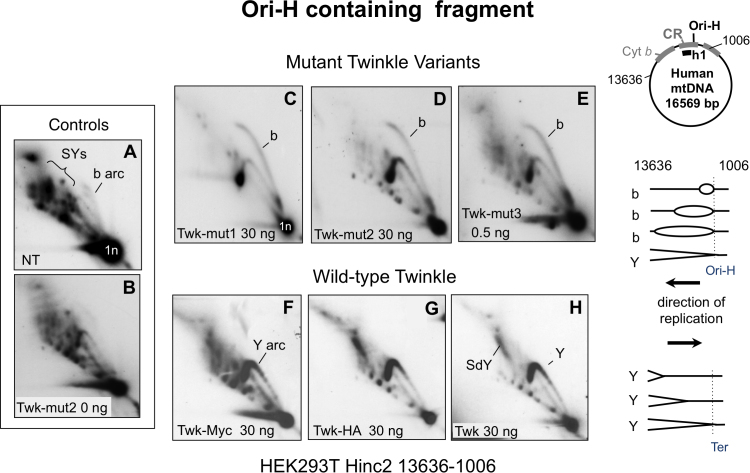Figure 2.
Elevated expression of wild-type Twinkle converts supra-Y arcs to standard replication fork arcs without an accompanying initiation arc. DNA of HEK293T cells was digested with Hinc2 and the products separated by 2D-AGE, and blot hybridized to a radiolabeled probe (h1) that detected the fragment of mtDNA spanning nt 13,636-1,006 (panels A–H). DNA samples derived from transformant cell lines carrying no transgene (A) or untagged Twinkle with no induction (0 ng doxycycline). (B); transgenic Twinkle with deleterious point mutations (C–E) (see Supplementary Figure S1), or without (F–H); with a C-terminal myc (F) or HA (C–E and G) tag; or untagged (H). Expression of the transgenes was induced with the indicated dose of doxycycline for 72 h, and confirmed by quantitative RT-PCR and immunoblotting (Supplementary Figure S7). Y – standard replication fork arc; SY - spra-Y arc; SdY – supra-double Y arc (see text, Supplementary Figures S2 and S5 and (10,14)); b – bubble or initiation arc; 1n – unit length fragment; i.e. 3.9 kb for the Hinc2 fragment nt 13,636-1,006. The Y and b arcs are designated fully duplex DNA intermediates on the basis of their 2D gel mobility (above), and enzyme resistance (Supplementary Figure S2). To the right interpretations of the b and Y arcs, assuming that in all cases a θ mechanism of replication is operating (see also Figure 6).

